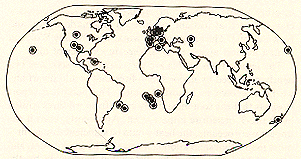
http://www.carleton.ca/~tpatters/teaching/intro/extinction/extinction11.html
In fact, Alvarez et al. saw this spike in
sedimentary rocks from
three different locations: Italy, New Zealand,
and Denmark. This proves that their iridium spike
was not caused by any local phenomenon, but
something truly global.
More recent work in fact has found iridium deposits
at the Cretaceous-Tertiary boundary all
over the world.

http://www.carleton.ca/~tpatters/teaching/intro/extinction/extinction11.html
This caused Alvarez et al. to suggest that an extraterrestial
body -- comet or asteroid -- had impacted the Earth
65 million years ago and caused sufficient climatological
destruction to wipe out the dinosaurs (and many other
creatures).
It's important to realize what a novel idea this
one. At the time, no one considered that an impact
could have killed the dinosaurs -- this was totally
a revolutionary idea.